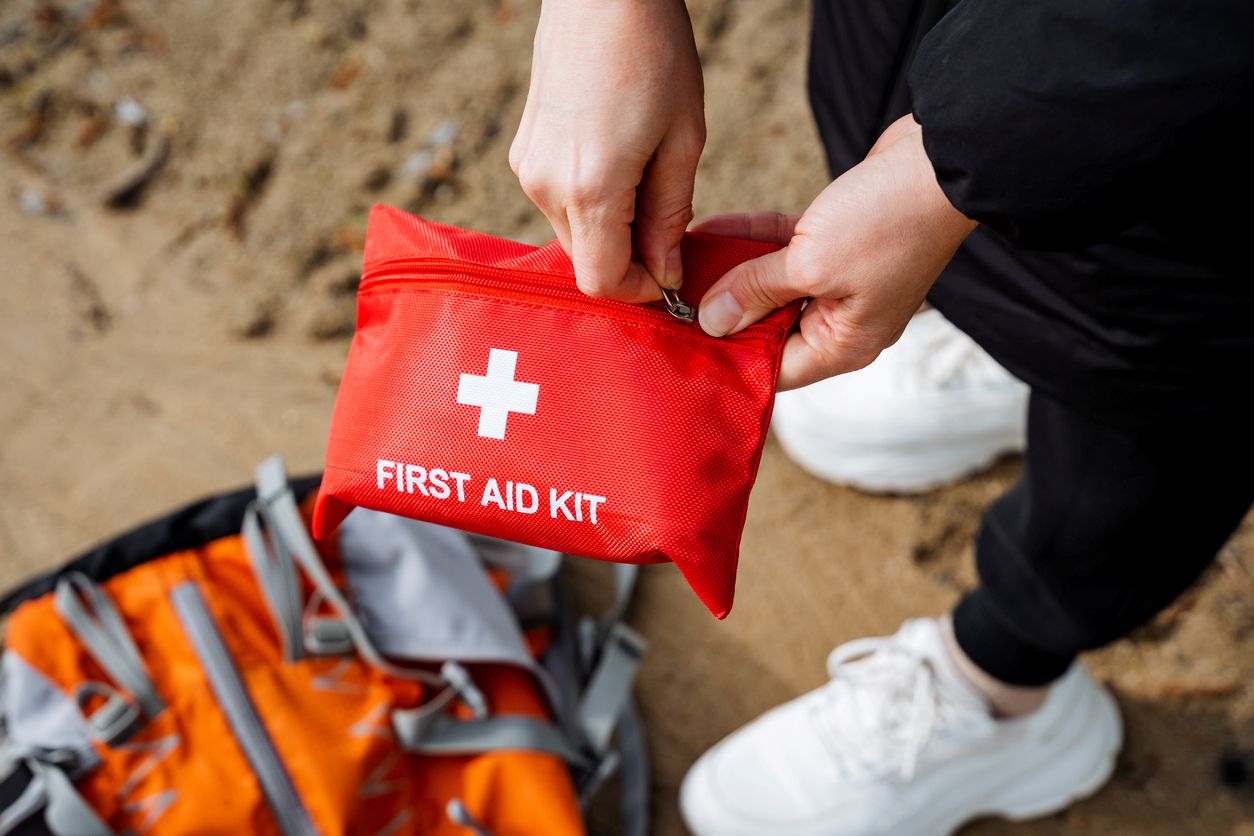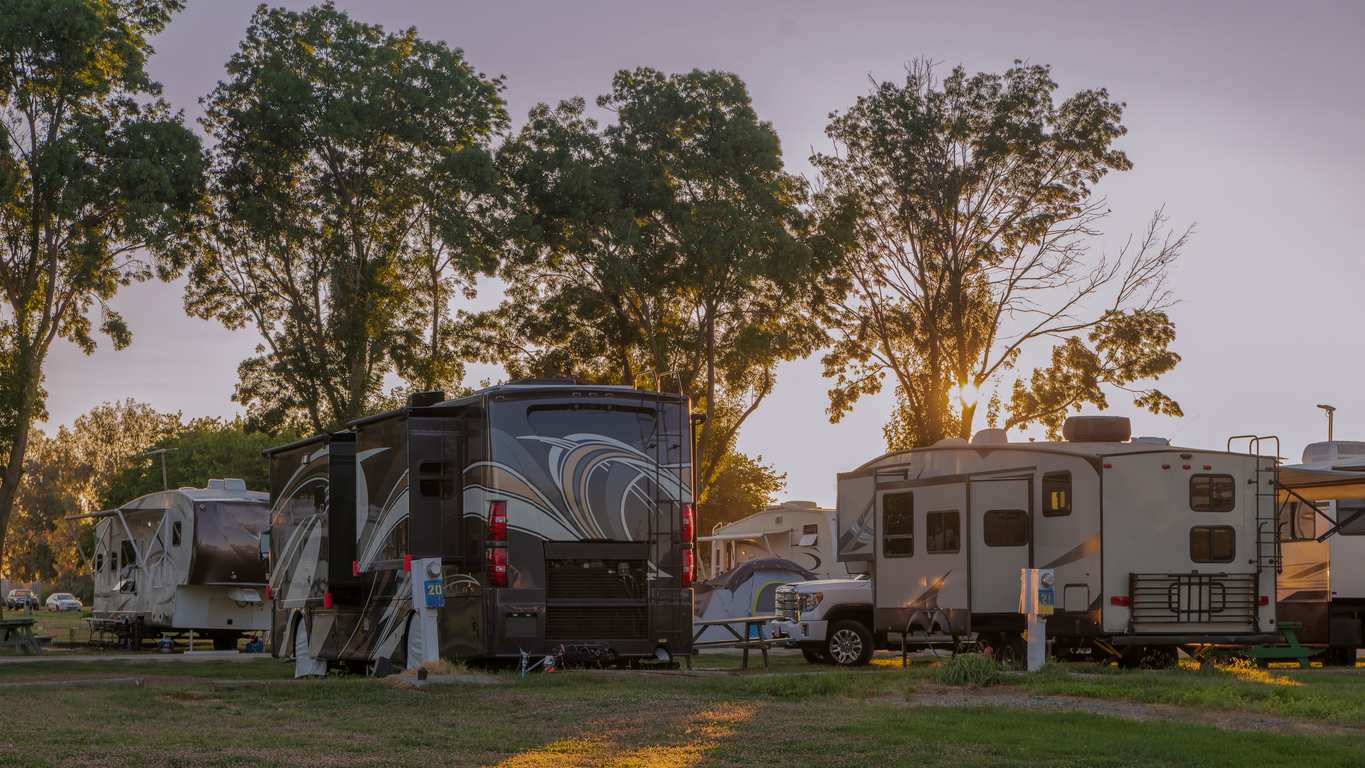Fall is here, and it’s the perfect time for adventure! If you love crisp mornings, warm campfires, and pretty views, RV camping is a great way to travel. Whether you’re visiting new places, setting up camp with family, or planning out your RV camping ideas, this guide is for you. If it’s your first trip or you want to make traveling easier, these RV camping tips for beginners from the expert team at Compass Self Storage will help you feel ready for the road.
1. Choose the Best RV for Your Lifestyle
Before your first trip, decide on the type of RV that best suits your travel style. Consider your budget, space requirements, and the frequency of your travel. Renting before buying can also help you determine what feels most comfortable.
Motor Homes
Motor homes are like small houses on wheels. They have a kitchen, bathroom, and a place to sleep—no need to set up a tent. Once you park, you can start relaxing straight away. However, since they’re larger than regular cars, driving and parking them can require a bit more practice.
Travel Trailers
Travel trailers are RVs you can tow behind your truck or SUV. As a result, you can drive your daily vehicle and bring your trailer along for the ride. Once you park and unhook the trailer, you’re free to use your vehicle to visit nearby towns, grab groceries, or go sightseeing without moving your entire campsite.
Camper Vans
Camper vans are smaller RVs that fit everything you need into a compact space that is easy to drive. They usually include a bed, a small kitchen area, and storage for your camping gear. Because they’re the size of a regular van, they’re easier to park and drive on highways or through small towns.
2. Plan Your First RV Trip
Planning your first trip is one of the most exciting parts of camping for beginners. Start small by choosing a nearby destination to keep your first adventure low-stress.
RV-Friendly Campgrounds
While you may want to hit the road as soon as possible, check if your campground can accommodate RVs before heading out. These sites will typically have ample space, easy parking, and hookups for water, power, and sewer. You can easily find out if your destination has these by checking out their website or calling ahead. It’s also smart to book your space early, especially in the fall.
Fuel Stops and Rest Areas
When planning your RV adventure, it’s helpful to map out your route in advance. Look for fuel stops where your RV can easily fit at the pump, so you don’t have to worry about tight spaces. Don’t forget to add rest areas along the way where you can stretch, grab a snack, or take a walk with your pets.
Take It Slow and Enjoy the Journey
For your first RV trip, keep your daily driving time short. Long drives can be tiring, especially if you’re not used to handling a larger vehicle. By driving fewer hours, you’ll have more energy to set up your campsite, investigate the area, and actually enjoy the trip.
3. Arriving and Parking Carefully
If you’re not used to parking your RV yet, take it slow and steady when you arrive at your campsite. Find a flat and open space that’s easy to park in, and carefully look for trees, rocks, or picnic tables that could potentially get in your way as you attempt to park. Once you’ve done so, use leveling blocks or stabilizers to make sure your RV sits evenly on the ground.
4. Connecting Your Hookups
Hooking up your RV is easier than it looks. Follow these steps and always double-check your connections before using your water or power systems.
Connect the Power
When setting up your RV, it’s important to connect the power cable before turning on the electricity. This keeps your equipment secure and avoids deterioration. Start by making sure the power pedestal at your campsite is off. Then, carefully plug your RV’s power cord into the outlet. Push it in all the way so it doesn’t come loose. Once the cable is secure, flip the breaker switch to turn on the power.
Attach the Freshwater Hose

Attach the freshwater hose to your RV’s water system carefully and check for leaks. Start by connecting one end of the hose to the freshwater hookup at the campsite, then connect the other end to your RV’s city water inlet. Twist the ends tightly, but avoid overtightening, as you want a snug, secure fit.
Once you attach everything, slowly turn on the water. This gives you time to spot any drips or loose connections before water flows at full pressure. If you notice a small leak, try tightening the hose slightly or replacing the rubber washer inside the connector. It’s also a good idea to use a water pressure regulator to maintain your RV’s plumbing.
Connect the Sewer Line
When it’s time to empty your RV’s holding tanks, connect the sewer line securely before dumping. This step keeps everything clean with no spills or surprises. Start by putting on disposable gloves to shield your hands. Next, attach one end of your sewer hose firmly to your RV’s waste outlet. Make sure it clicks or twists into place, depending on your RV’s setup. Then, connect the other end of the hose to the dump station or campsite sewer hookup.
It should fit tightly to avoid leaks or unpleasant odors. Once the hose is secure on all ends, double-check the connections. Lock the elbow fitting in place, so the hose is neither twisted nor loose. Only after you seal everything should you slowly open the black tank valve, followed by the gray tank valve. This helps rinse the hose with gray water after dumping.
5. Creating a Comfortable Campsite Setup
Make your campsite feel warm and welcoming by turning it into an outdoor retreat. Start by laying down a welcome mat to keep dirt out of the RV. You can also set up camping chairs for everyone to have a cozy place to relax, and hang string lights to make the space feel relaxing after dark.
6. Packing Smart for the Road
Packing for an RV trip is all about organization. Create a checklist that includes camping essentials for beginners and use stackable bins and labeled compartments to keep everything in reach without clutter.
RV and Trip Tools
It makes a huge difference for your road trip if you have the appropriate tools on hand in your RV. For example, a flashlight could be useful when you’re setting up camp at night, checking your hookups in the dark, or if you’re trying to find something in your RV without waking up everyone by turning on the lights.
Wrenches are also great to have, especially if you need to tighten any bolts or fittings around your water or sewer connections. This will save you from small repairs turning into major problems later on during your trip.
Kitchen Supplies
Cooking in your RV can be an enjoyable experience when you have the necessary kitchen supplies to make it easy. With a few sturdy pots and pans, you can prepare quick meals like pasta, soup, or any of your breakfast favorites.
But how can you cook those meals without the necessary utensils? Pack spatulas, tongs, spoons, and a sharp knife to chop ingredients easily, so you don’t end up going hungry!
Precautionary Items

Security should always be a top priority when camping in an RV. A first aid kit can be useful for treating small injuries like cuts, scrapes, or bug bites. Make sure it includes bandages, antiseptic wipes, pain relievers, and any personal medicines you might need.
As for a fire extinguisher, it’s equally important to have one in your RV. Keep it in a convenient spot so you can act quickly if there’s a small fire near the stove or electrical hookups. It’s also a good idea to confirm it works properly ahead of time.
7. Cooking and Eating on the Go
Since RV kitchens are usually small, it helps to plan quick meals. Try making one-pot dishes like chili, pasta, or soup to keep cooking convenient and cleanup fast. If you love grilling, pack your favorites, such as burgers, hot dogs, or veggies, for quick outdoor meals.
8. Staying Clean and Comfortable
RV bathrooms may be small, but they’re manageable to handle with a few smart habits. Use RV-safe toilet paper to prevent clogs in your tanks, and conserve water when showering to extend your supply. Don’t forget to keep cleaning wipes nearby for quick cleanups and to keep everything fresh between stops.
9. RV Tips for Beginners
When you’re taking weekend getaways or long hauls, these RV tips for beginners can make every journey easier.
Pre-Trip Inspection
Before you start your trip, it’s important to secure your RV and prepare to go. Do a pre-trip inspection to catch any problems early. You can begin by checking your tires for good air pressure, wear, or deterioration. This will help avoid flats on the road.
Emergency Gear
Make sure you’re ready for anything that might happen on the road by packing emergency gear and a roadside kit. Begin with the essentials, such as jumper cables, a spare tire, and a tire repair kit, in case of a flat tire. Add spare batteries for your flashlight and road flares or reflective triangles so other drivers can see you if you need to pull over.
Dump Stations, Fuel, and Campgrounds

You can make traveling much easier by using RV apps during your trip. Apps like Campendium or RV Life can help you locate dump stations, fuel stops, and campgrounds near your current location. You can also use these apps to read reviews, see photos, and check campground amenities before you arrive.
10. Respecting Nature and Fellow Campers
One of the best parts of RV camping is spending time in nature and meeting other travelers along the way. Always follow the leave no trace rule, which means taking back whatever you bring with you when you leave. Also, try to keep your noise level down at night so everyone can enjoy the peaceful outdoors, and be sure to dispose of trash and waste properly.
11. Clean and Prep Your RV for Storage
Empty and Rinse Holding Tanks
Before storing your RV or heading home, it’s important to empty and rinse your holding tanks. Start by draining the black water tank, which holds waste, first, then the gray water tank, which holds sink and shower water. This helps wash out the sewer hose and keeps it cleaner.
Clean the Interior and Remove Any Food
Take time to clean the inside of your RV before parking it for storage. Wipe down counters, tables, and appliances to remove crumbs and spills. Sweep or vacuum the floors, and check every cabinet and drawer for leftover snacks or ingredients. A few crumbs can attract pests, so you should remove all food, including dry goods and canned items.
Check for Leaks and Protect Against Pests and Moisture
Before storing your RV, inspect it carefully for any leaks or cracks on the roof, windows, and doors. Small openings can let in water or bugs, which can cause harm over time. Seal any cracks or gaps with weatherproof caulk or tape to prevent moisture and pests from entering. Inside, place moisture absorbers or dehumidifiers to reduce mold and mildew, especially if you plan to store your RV in a humid area.
Keep Your RV Secure With Compass Self Storage
If it’s your first road trip or another adventure on your list, Compass Self Storage can help you stay organized every step of the way.
Find a storage location near you and give your vehicle a secure RV storage space to park until it’s time to hit the road again.
